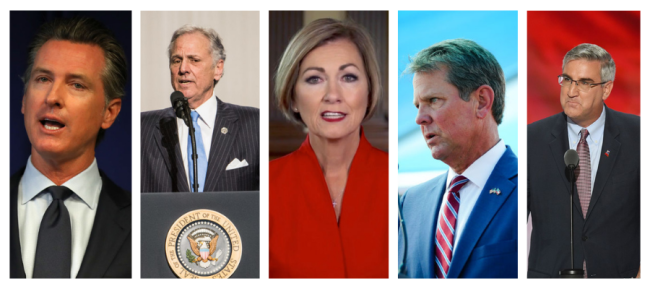You have /5 articles left.
Sign up for a free account or log in.

Governors have made various funding proposals for higher education this budget year. From left to right: Gavin Newsom, Henry McMaster, Kim Reynolds, Brian Kemp and Eric Holcomb.
Justin Sullivan/Staff, Sean Rayford/Stringer, the Committee on Arrangements for the 2020 Republican National Committee, Elijah Nouvelage/Stringer, Jim Watson/Staff, all via Getty Images
Many states slashed higher education funding last year, fearing the pandemic would torpedo state revenues. The higher education sector, no stranger to steep cuts during economic recessions, braced for further budget reductions in the 2022 fiscal year.
But many public higher education officials’ worst fears have not been realized -- at least not yet, experts say. Governors’ proposed state budgets are a mixed bag, with several states pushing to increase higher education funding or at least restore last year’s cuts.
“We’re seeing almost as many budget proposals protecting or bolstering higher ed as we are cutting higher ed,” said Sunny Deye, program director for postsecondary education at the National Conference of State Legislatures.
Several governors acknowledged higher education is important to economic recovery, Deye said. Unlike in past recessions, many public institutions might not have untapped pricing flexibility, meaning that can't make up any cuts in the state funding by raising tuition.
“There’s an understanding in this recession, more so than those in the past, that tuition has really been pushed about as far as it could go,” Deye said. “Given the pandemic and the economic situation that we’re in, higher ed investments are going to be critical to get economies back on track.”
Sarah Pingel, a senior policy analyst at the Education Commission of the States, has been tracking education-related proposals in governors’ State of the State addresses. Typically, governors touch on college affordability, tuition prices and higher education finance. But this year, messaging around higher education is different. Governors have focused on what Pingel identified as three major themes: colleges’ role in workforce development, higher education financial stability and assistance to historically Black colleges and universities.
Governors from both parties have offered new money for higher education. In his State of the State address, Kentucky's governor, Democrat Andy Beshear, called for an additional $17 million for postsecondary education. Governor Henry McMaster of South Carolina, a Republican, proposed using the state’s capital reserve fund to repair, renovate or replace deteriorating college buildings. Republican Bill Lee, the governor of Tennessee, suggested $900 million for capital improvements to higher education and state infrastructure, and Virginia governor Ralph Northam, a Democrat, proposed additional assistance for HBCUs.
Governors in Alabama, Alaska, Arkansas, Connecticut, Georgia, Indiana, Michigan, Missouri, Nebraska, New Jersey, New Mexico, New York, North Dakota, Oklahoma, Rhode Island, South Dakota, Utah, Vermont and Washington also included higher education finance or policy initiatives in their State of the State addresses. But not all of them coupled their rhetoric with funding increases. The annual speeches serve as good indicators of state priorities, but governors don’t include itemized lists of their proposed cuts, Pingel said.
“The governor isn’t going to mention in their State of the State address that they’re cutting higher ed funding. The topic that they’re going to mention in their State of the State is where they’re going to look for increases or additional funding,” she said. “It could be that just looking at State of the State addresses is why we’re seeing governors talk about increasing funding to higher ed. And it could be that if you were to look at the governor’s proposed budgets as they come out, the evidence might not jive.”
Budget Processes Vary
The procedures and timelines for passing budgets vary from state to state, but most follow a similar core process. First, state agencies send their budget requests to the state budget office, which develops an executive budget proposal based on the agency requests and the governor’s financial priorities. Between November and March, governors send their executive budget proposals to state legislatures, which deliberate and edit the proposal before passing a final budget. Before it becomes law, the governor must sign the budget, and in some cases the governor can use line-item veto power to make changes to the budget before it’s enacted.
Governors’ budget proposals are often presented in January alongside their State of the State addresses.
The start date for the fiscal year also varies across states. Forty-six states will begin the 2022 fiscal year on July 1, 2021. New York will begin fiscal year 2022 on April 1, 2021. Texas starts fiscal year 2022 on Sept. 1, 2021, and Alabama, Michigan and the District of Columbia begin their 2022 fiscal years on Oct. 1, 2021.
So far, governors have proposed a patchwork of higher education funding increases and cuts in their budgets, Deye said. California is looking at a 3 percent increase. Idaho is considering bumping up higher education funding by 2.6 percent. Iowa and Indiana have also suggested small increases to higher education budgets.
Governors in Georgia, Hawaii, Nevada and North Dakota -- all of whom included higher education in their State of the State addresses -- have proposed cuts. Some states that are considering higher education funding decreases are banking on federal assistance to fill out their budgets, Deye said.
“Everyone is waiting with bated breath,” she said. “Either the economy could rebound and their numbers could look a lot better -- which did happen last year in a lot of states -- or the feds could come in with money. Whether it’s money to directly support higher ed or whether it’s money to support states and localities -- that’s going to make a big difference to where state budgets land by July.”
Performance-based funding models are becoming increasingly popular, despite some research that suggests they do little to boost student achievement and can introduce unintended consequences. All but nine states tied at least some higher education dollars to performance metrics.
As lawmakers learn more about the effects of performance-based funding, they’re working to fine-tune the benchmarks to better support institutions that enroll low-income and underserved students.
“A lot of states have been moving toward outcome-based funding, and they’re still tinkering with those formulas, but I think there’s a slow move towards starting to be more specific about outcomes for previously underserved populations,” Deye said.
Colorado, for example, will adjust its funding model this summer to reward colleges for admitting and graduating students of color, low-income students and students whose parents didn’t attend a four-year college. Experts are still unsure whether Colorado’s changes will benefit the state’s chronically underfunded institutions, but Deye said baking specific goals into the funding model can help minimize some of the unwanted side effects of performance-based funding.
“I think the goals that legislators set up for their higher education institutions are becoming more specific through the funding models,” she said. “They can pinpoint where they want to hold institutions’ feet to the fire.”
Deye also predicts states will re-examine their merit-based financial aid programs to determine if they still serve student achievement goals.
Some states are doubling down on student completion of the Free Application for Federal Student Aid. This year especially, student completion of the federal aid application is down.
Public high school students in Louisiana, Texas and Illinois are required to complete the FAFSA, Deye said. Indiana lawmakers recently advanced a similar measure.
State legislatures still have a long way to go before passing their final budgets, Pingel said. Most states don’t begin the next fiscal year until July. Until then, Pingel and Deye will be keeping an eye on states' higher education funding plans to see what they say -- and how they might differ from the proposals governors have been making.
Read on for additional details on proposed budgets in a handful of states to watch.
California
Governor Gavin Newsom, a Democrat, proposed an $18.6 billion budget for higher education in fiscal year 2022. The proposed budget reflects a 3 percent increase for the sector and includes a $786 million general fund increase for the University of California and California State University systems.
The budget includes $136.3 million in new ongoing support for the University of California system, $103.9 million of which will partly restore a $300.8 million funding cut the system weathered last year. The budget also earmarks $144.5 million in recurring funding and $225 million in one-time funding for the California State University system.
A handful of higher education systems and organizations applauded Newsom’s proposal when it was released in January, including the University of California system, the California State University system, the Community College League of California, the UC Student Association and the California Faculty Association.
Georgia
Georgia is looking at a $280 million cut to higher education funding, which makes up about 14 percent of Republican governor Brian Kemp’s proposed budget for fiscal year 2022. The cut would primarily come from funds dedicated to teaching, according to the Georgia Budget & Policy Institute. The $280 million would reflect spending changes compared to the state's fiscal year 2020 budget and would not be below budget reductions made in the middle of last year as a result of the pandemic.
Kemp also proposed using $5 million to establish a pilot program to help college juniors and seniors who have fallen behind on tuition payments finish their degrees.
Hawaii
Higher education officials in Hawaii are bracing for damaging cuts. Governor David Ige, a Democrat, said the University of Hawaii system will have to cut $78 million from its fiscal 2022 and 2023 budgets, which would equate to a 15 percent reduction in operating costs across the system.
The University of Hawaiʻi at Mānoa would take the biggest reduction of $35.6 million, The Honolulu Star-Advertiser reported. The John A. Burns School of Medicine would lose $3 million. The University of Hawaiʻi Hilo is looking at $5.7 million in cuts. The University of West Oahu would see $2.7 million in cuts, and the University of Hawaiʻi Community Colleges are facing a budget reduction of $23 million.
Idaho
Idaho governor Brad Little, a Republican, proposed restoring public funding for higher education after it was cut during the pandemic. His budget proposal includes a 2.6 percent increase for higher education and a 5.45 percent increase for community colleges in the state.
Little’s budget also includes a $14.2 million rainy day fund for colleges and universities and a $4.8 million investment in career and technical education programs in Idaho.
Meanwhile, the Idaho House Education Committee has introduced a bill that could chip away at a small revenue stream for Idaho colleges and universities. The bill would allow students to opt out of some university fees -- for example, fees that fund diversity and inclusion centers, gender resources centers, club sports, advising, childcare, student support services, student wellness, sustainability centers, and minority student programs.
Indiana
Indiana’s higher education budget may increase slightly in fiscal year 2022. In June, the state cut funding for the sector by 7 percent, fearing steep revenue losses as a result of the pandemic.
In his proposed budget, Governor Eric Holcomb, a Republican, proposed restoring the 7 percent, $103 million cut for the next two years. He has also asked lawmakers to increase the higher education budget by 1 percent in the first year of the new budget and by another 1 percent during the second.
Holcomb’s budget would also fund a request for need-based aid submitted by the state’s Commission for Higher Education, according to The Indianapolis Star.
This week, Indiana lawmakers advanced a bill that would require all public high school students to complete the Free Application for Federal Student Aid. Only six in 10 of Indiana’s 2020 public high school graduates completed the FAFSA, leaving $70 million in federal aid on the table, the Associated Press reported. The measure awaits a vote in the state's House of Representatives.
Nevada
The Nevada System of Higher Education could face an $80 million budget reduction in fiscal 2022 if lawmakers stick with Democratic governor Steve Sisolak’s proposal. In his January budget proposal, Sisolak suggested $7 billion in total funding for K-12 and higher education.
The $7 billion includes $24 million per year for student enrollment growth and $4.4 million per year for the Silver State Opportunity Grant, a need-based financial aid program for low-income students at state colleges.
The state is banking on federal aid to fill out its education budgets, the Reno Gazette-Journal reported. Officials expect to receive $100 million to cover lost revenue and expenses related to distance learning and financial aid.
North Dakota
Governor Doug Burgum, a Republican, proposed slashing the North Dakota University System’s funding by 7.5 percent, taking the system’s base budget from $648.7 million to $629.3 million, the Grand Forks Herald reported. The system requested $660.5 million.
Officials are worried the cuts will result in job losses, but Burgum has challenged institutions to find new ways to configure their budgets. Public dollars make up about a quarter of the system’s budget, while tuition revenue, grants, donations and other federal funding fill in the rest.



